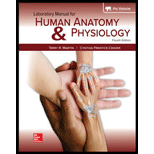
Pre-Lab Questions Select the correct answer for each of the following questions:Fibrous joints are structural types containinga. cartilage
b. dense fibrous connective tissue.
c. synovial membranes.
d. synovial fluid.
Introduction :
The connection between two bones is termed as joint. The fibrous joint abundantly contains collagen. These joints are immovable, thus are called fixed joints. The fibrous joint is present between skull bones and called suture. There is no space or cavity in fibrous joint.
Answer to Problem 1PL
Correct answer :
The correct answer is option (b) dense fibrous connective tissue.
Explanation of Solution
Explanation/justification for the correct answer :
Option (b) dense fibrous connective tissue. The fibrous joints are immovable consisting of dense fibrous connective tissue. The immobile nature of such a joint is due to no space or cavity between bones. The fibrous joints are gomphoses, syndesmoses, and sutures. So, the correct answer is option (b).
Explanation for incorrect answer :
Option (a) cartilage. The cartilage is flexible and soft connective tissue present in knees, ankles, and elbow. Hyaline cartilage is present at most of the joints. Cartilage is present only in the cartilaginous joint. So, this is an incorrect option.
Option (c) synovial membrane. The synovial membrane is present in the synovial joint and acts as a shock absorber. The inner surface of the synovial joint is lined by synovial membrane. So, this is an incorrect answer.
Option (d)synovial fluid. The synovia or synovial fluid is secreted by the synovial membrane. This fluid acts as a lubricant, nourisher and shock absorber for bones. It reduces the friction between cartilages. So, this is an incorrect answer.
Want to see more full solutions like this?
Chapter 19 Solutions
Laboratory Manual For Human Anatomy & Physiology
Additional Science Textbook Solutions
Microbiology with Diseases by Taxonomy (5th Edition)
Microbiology with Diseases by Body System (4th Edition)
BIOLOGY:THE ESSENTIALS (LL) W/CONNECT
Biological Science (6th Edition)
- An example of an interosseous fibrous joint is____ A) Clavicle and scapula at the distal ends. B) Between the vertebrae. C) Between the humerus and the glenoid cavity D) The radius and the ulna along its length. Please give a quick explanation for each correct & incorrect. Thanksarrow_forwardSelect the best answer or answers from the choices given: A bone with approximately the same width, length, and height is most likely (a) a long bone, (b) a short bone, (c) a flat bone, (d) an irregular bone.arrow_forwardA meniscus is found in thea. shoulder joint. c. hip joint. e. ankle joint.b. elbow joint. d. knee jointarrow_forward
- What effect would exaggerated exercise or the complete lack of exercise have on bones such as the tibia, femur, and humerus if it occurred during childhood? During adulthood? Please, write answer on your own words, no copy and paste, thank youarrow_forwardWhich of these joints is classified as a biaxialdiarthrosis?a. the metacarpophalangeal joint b. the hip jointc. the elbow jointd. the pubic symphysisarrow_forwardMusculo skeletal examination: Cervical Spine1. Contour:2. Mass or deformity:3. Pain:4. Swelling:arrow_forward
- Below is the description of two joints. Choose the joint that is less likelyto become injured. Joint A - diarthosis joint; two long bones join to form it; capable of flexion and extension only; non-weight bearing. Joint B - diarthosis joint; two long bones join to form it; capable of flexion, extension, abduction, adduction and circumduction; non-weight bearing. possible answers: joint A jointB no answer from provided text.arrow_forwardExamine the thorax using a skeleton or an illustration. Classify the various joints you see as containing either hyaline cartilage, fibrocartilage, or fibrous tissue (fibrous joints).arrow_forwardThe knee is superior to the ankle. A. True b. Falsearrow_forward
 Medical Terminology for Health Professions, Spira...Health & NutritionISBN:9781305634350Author:Ann Ehrlich, Carol L. Schroeder, Laura Ehrlich, Katrina A. SchroederPublisher:Cengage Learning
Medical Terminology for Health Professions, Spira...Health & NutritionISBN:9781305634350Author:Ann Ehrlich, Carol L. Schroeder, Laura Ehrlich, Katrina A. SchroederPublisher:Cengage Learning Fundamentals of Sectional Anatomy: An Imaging App...BiologyISBN:9781133960867Author:Denise L. LazoPublisher:Cengage Learning
Fundamentals of Sectional Anatomy: An Imaging App...BiologyISBN:9781133960867Author:Denise L. LazoPublisher:Cengage Learning Comprehensive Medical Assisting: Administrative a...NursingISBN:9781305964792Author:Wilburta Q. Lindh, Carol D. Tamparo, Barbara M. Dahl, Julie Morris, Cindy CorreaPublisher:Cengage LearningBasic Clinical Lab Competencies for Respiratory C...NursingISBN:9781285244662Author:WhitePublisher:Cengage
Comprehensive Medical Assisting: Administrative a...NursingISBN:9781305964792Author:Wilburta Q. Lindh, Carol D. Tamparo, Barbara M. Dahl, Julie Morris, Cindy CorreaPublisher:Cengage LearningBasic Clinical Lab Competencies for Respiratory C...NursingISBN:9781285244662Author:WhitePublisher:Cengage





